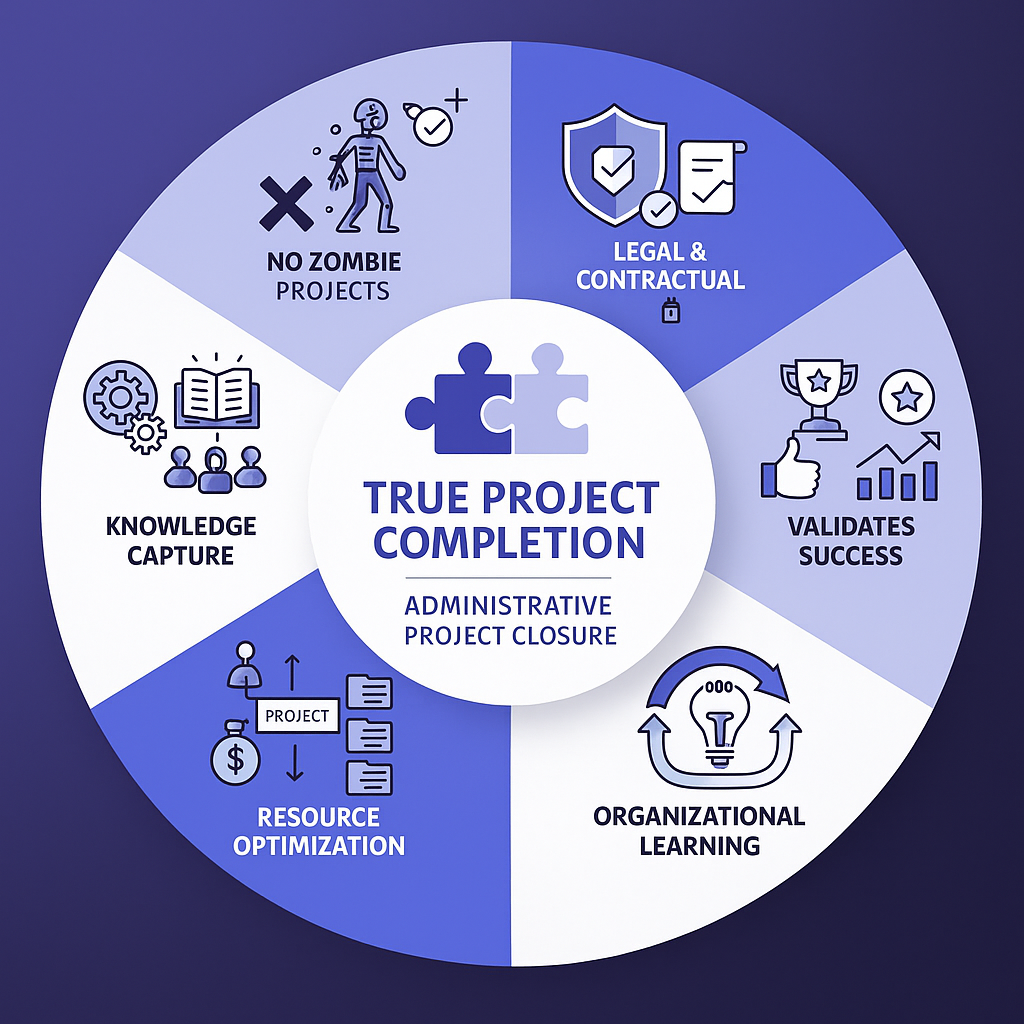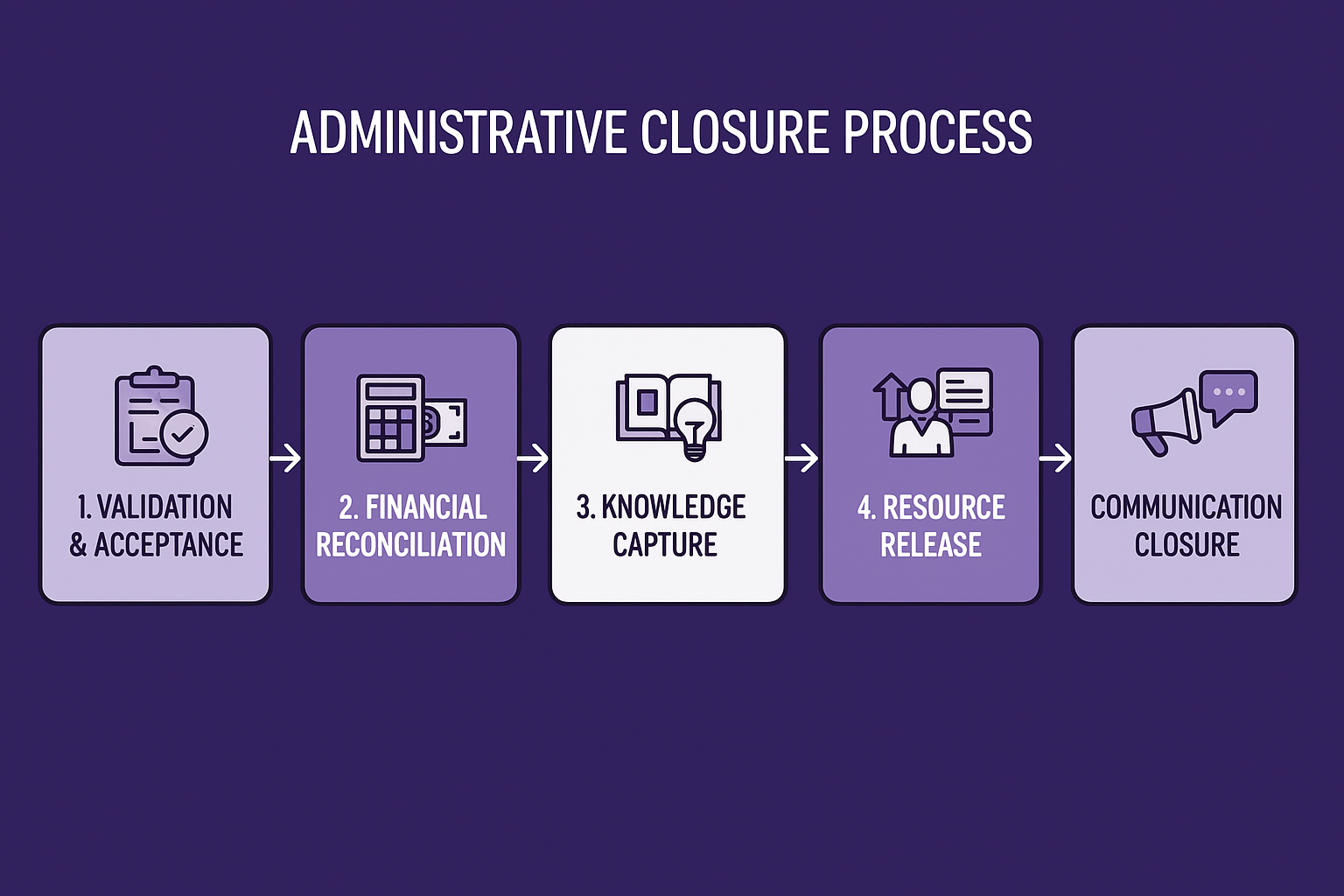A surprising number of projects, some studies suggest, nearly one in three, quietly drain money and staff time long after delivery. The culprit isn’t poor execution but the lack of a final closure step.
That’s why administrative closure matters for project completion, ensuring work isn’t just finished on paper but officially wrapped up, documented, and transformed into lasting organizational value.
In this article, we will:
- Show how administrative project closure drives true completion
- Simplify administrative closure into a clear step-by-step roadmap
- Clarify the distinction between administrative closure and project closure
Administrative project closure: Why it drives true project completion
Administrative closure transforms technically finished projects into organizationally valuable deliverables that generate lasting impact. Without this critical final phase, even well-executed projects remain incomplete, consuming resources and failing to deliver their intended value.
Let's explore the specific reasons why administrative closure matters for genuine project completion:

Prevents project "zombie state"
Projects without proper closure often enter a dangerous limbo phase where they consume organizational resources indefinitely. Teams remain tied to supposedly "finished" work, preventing reassignment to new initiatives.
Budget accounts stay open, creating confusion about actual project costs and available funding. Vendor contracts remain unsettled, leading to ongoing financial obligations and potential disputes.
Key impacts:
- Team members cannot be formally released for new projects
- Budget accounts remain open, preventing accurate financial reporting
- Equipment and facilities stay allocated to completed work
- Vendor relationships remain unsettled, creating legal exposure
Pro tip: Create a formal resource release checklist that triggers automatically when technical completion is achieved. This prevents projects from accidentally entering a zombie state.
Ensures legal and contractual completion
Formal administrative closure provides essential legal protection by documenting proper contract fulfillment and stakeholder acceptance. This process shields organizations from future liability issues and vendor disputes that can arise months or years after project delivery.
According to PMI research, organizations with strong closure practices experience significantly fewer legal complications compared to those with informal or incomplete closure processes.
Key benefits:
- Formal acceptance documentation prevents future liability claims
- Contract closure protects against vendor payment disputes
- Compliance documentation shields the organization from regulatory audits
- Clear handoff procedures establish ongoing support responsibilities
Research insight: Organizations implementing systematic closure processes report reduced legal and compliance issues, with formal documentation serving as the primary protection mechanism against post-project disputes.
Captures critical knowledge before team dispersal
Teams naturally dissolve quickly after technical completion, taking valuable project knowledge with them. Research shows that capturing lessons learned is essential for organizational knowledge retention, yet many organizations fail to systematically document insights before team members move to new assignments.
According to PMI studies on knowledge management, organizations that systematically capture lessons learned show measurably better performance on subsequent projects through reduced learning curves and mistake avoidance.
Critical knowledge areas:
- Technical solutions that worked well or failed
- Process improvements discovered during execution
- Stakeholder management insights and relationship notes
- Risk mitigation strategies that proved effective
Pro tip: Schedule lessons learned sessions before technical completion rather than after. Team members are more engaged and available when they're still actively working on the project.
Validates true project success
Technical completion doesn't guarantee stakeholder satisfaction or business value delivery. Administrative closure includes formal validation that the project achieved its intended outcomes and met stakeholder expectations.
Project management statistics indicate that 70% of projects globally fail to deliver their promised value, often because success measurement occurs only at technical completion rather than through comprehensive closure validation.
Validation components:
- Formal stakeholder sign-offs confirming satisfaction
- Business value measurement against original objectives
- Quality verification through independent testing or review
- Performance metrics validation against baseline requirements
Industry insight: The disconnect between technical delivery and stakeholder satisfaction represents one of the most significant gaps in project management, making formal validation through administrative closure essential for true success measurement.
Enables resource optimization
Proper closure releases human resources, budget allocations, and physical assets for optimal organizational use. Without formal closure, these resources remain tied to completed work, reducing overall organizational efficiency.
According to PMI research, organizations that invest in proven project management practices, including proper closure, waste 28 times less money than organizations with poor project performance.
Resource optimization benefits:
- Human resources becomes available for new strategic initiatives
- Budget accounts close, providing accurate financial reporting
- Equipment and facilities return to the organizational resource pool
- Vendor relationships conclude properly, enabling future partnerships
Pro tip: Develop resource release timelines that align with project phases rather than waiting for complete technical finish. This enables faster resource reallocation.
Establishes an organizational learning loop
Administrative closure creates a systematic knowledge transfer mechanism that feeds insights into future project planning and execution. This organizational learning loop drives continuous improvement and helps avoid repeating costly mistakes.
Research on lessons learned application demonstrates that organizations with systematic knowledge capture and application processes show measurable improvement in subsequent project success rates through better risk management and process refinement.
Learning loop components:
- Searchable repository of project experiences and solutions
- Process improvement recommendations for PMO standards
- Best practice documentation for similar future projects
- Risk and issue database for proactive future management
Key research finding: Organizations implementing comprehensive lessons learned processes demonstrate 31% higher success rates on subsequent projects compared to those with informal or absent knowledge capture systems.
Administrative closure bridges the gap between project completion and organizational value, ensuring that every project contributes to long-term success rather than simply checking technical boxes.
Administrative closure made simple: Your step-by-step completion roadmap
Executing administrative closure without a systematic approach leads to missed deadlines, incomplete documentation, and confused stakeholders. This structured roadmap transforms closure from a chaotic scramble into a predictable, manageable process that protects your organization while maximizing project value.

Step-by-step closure process
Administrative closure follows a logical sequence that builds from stakeholder validation through final documentation archiving. Each step depends on the successful completion of the previous phase, making proper sequencing critical for efficient closure.

Phase 1: Validation and acceptance (Days 1-3)
- Verify all deliverables meet acceptance criteria
- Obtain formal stakeholder sign-offs and approvals
- Document any scope variances with stakeholder acknowledgment
Phase 2: Financial reconciliation (Days 2-5)
- Process final invoices and expense claims
- Resolve vendor payments and contract obligations
- Secure lien releases and warranty documentation
Phase 3: Knowledge capture (Days 4-7)
- Conduct lessons learned sessions with key team members
- Document technical solutions and process improvements
- Archive all project records and compliance materials
Phase 4: Resource release (Days 6-8)
- Formally release team members to new assignments
- Return equipment and facilities to the organizational pool
- Complete security deprovisioning and access management
Phase 5: Communication closure (Days 7-10)
- Announce project completion to all stakeholders
- Provide operational transition guidance and support contacts using a project management software for operations teams to track ownership after go-live.
- Celebrate team achievements and project success
Timeline considerations for efficient execution
Proper timing prevents resource conflicts while ensuring thorough completion of all closure activities. Most administrative closure processes require 7-10 business days when properly planned and executed.
Critical timing factors:
- Begin closure planning 2 weeks before technical completion
- Allow 3-5 days of overlap between phases for dependencies
- Schedule lessons learned sessions while team members are still engaged
- Complete financial reconciliation before team dispersal
- Buffer extra time for complex contracts or regulatory requirements
Roles and responsibilities matrix
Clear accountability prevents task duplication and ensures comprehensive coverage of all closure requirements. Assign primary ownership while identifying supporting roles for each major activity.
Essential document templates and forms
Standardized templates ensure consistent closure quality while reducing preparation time for busy project teams. These templates also facilitate knowledge sharing across different projects and teams.
Required closure documentation:
- Project completion certificate with stakeholder signatures
- Financial reconciliation summary with all payments verified
- Lessons learned report template with improvement recommendations
- Document archive inventory with location references
- Resource release forms with security clearance confirmation
- Closure communication template with stakeholder contact updates
Pro tip: Create a master closure checklist that incorporates these templates and tracks completion status. This single document becomes your closure command center, ensuring nothing gets overlooked during the typically hectic project end phase.
Following this systematic approach transforms administrative closure from an afterthought into a value-generating process that strengthens your organization's project management capabilities.
Administrative closure vs project closure: Understanding the distinction
Many project managers confuse administrative closure with overall project closure, leading to incomplete project finalization and missed opportunities for organizational learning.
Understanding these distinct but interconnected processes ensures that your projects deliver maximum value while setting the foundation for future success.
In simple terms, administrative closure is about tidying up the house, while project closure is locking the door and handing over the keys. One focuses on the paperwork and organizational memory; the other confirms that the actual project has truly ended.
By treating both as mandatory steps, you’ll reduce compliance risks, avoid disputes, and leave behind a well-documented trail that strengthens future projects.
Structured closure builds organizational resilience
Administrative closure is the discipline that transforms projects from “technically done” into strategically complete. By documenting outcomes, securing compliance, capturing lessons, and freeing resources, organizations build a cycle of trust and continuous improvement.
This structured approach doesn’t just close projects; it strengthens resilience, reduces risk, and equips teams to handle future challenges with confidence. Treat closure as a strategic investment, and every project becomes a building block for long-term success.


%20(1).jpg)
_light%201.png)





